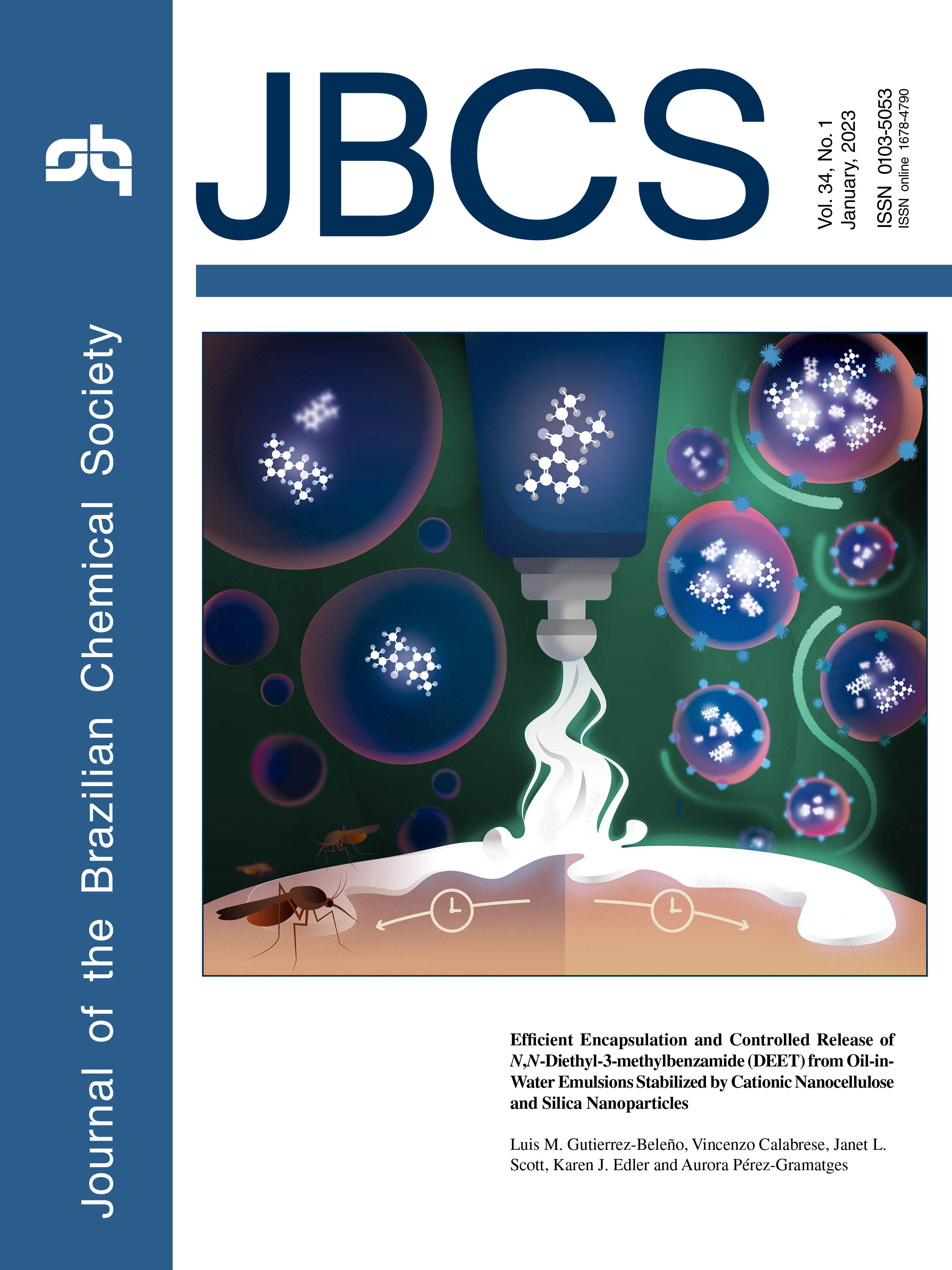vol. 34, No. 1, 2023, p. 1-152
The efficient encapsulation of N,N-diethyl-3-methylbenzamide (DEET), an insect-repellent compound, in mineral oil-in-water emulsions was achieved using a tailored combination of surfactants, cationic cellulose, and silica nanoparticles. The combined action of these non-toxic materials as emulsion stabilizers allowed a sustained release of DEET for at least six hours, showing the potential of these formulations for an extended repellent effect. Details are presented in the Article Efficient Encapsulation and Controlled Release of N,N-Diethyl-3-methylbenzamide (DEET) from Oil-in-Water Emulsions Stabilized by Cationic Nanocellulose and Silica Nanoparticles by Luis M. Gutierrez-Beleño, Vincenzo Calabrese, Janet L. Scott, Karen J. Edler and Aurora Pérez-Gramatges on page 13.
Efficient Encapsulation and Controlled Release of N,N-Diethyl-3-methylbenzamide (DEET) from Oil-in-Water Emulsions Stabilized by Cationic Nanocellulose and Silica Nanoparticles
Luis M. Gutierrez-Beleño  ; Vincenzo Calabrese
; Vincenzo Calabrese  ; Janet L. Scott
; Janet L. Scott  ; Karen J. Edler
; Karen J. Edler  ; Aurora Pérez-Gramatges
; Aurora Pérez-Gramatges

The efficient encapsulation of N,N-diethyl-3-methylbenzamide (DEET), an insect-repellent compound, in mineral oil-in-water emulsions was achieved using a tailored combination of surfactants, cationic cellulose, and silica nanoparticles. The combined action of these non-toxic materials as emulsion stabilizers allowed a sustained release of DEET for at least six hours, showing the potential of these formulations for an extended repellent effect. Details are presented in the Article Efficient Encapsulation and Controlled Release of N,N-Diethyl-3-methylbenzamide (DEET) from Oil-in-Water Emulsions Stabilized by Cationic Nanocellulose and Silica Nanoparticles by Luis M. Gutierrez-Beleño, Vincenzo Calabrese, Janet L. Scott, Karen J. Edler and Aurora Pérez-Gramatges on page 13.
https://dx.doi.org/10.21577/0103-5053.20220084
Editorial J. Braz. Chem. Soc. 2023, 34(1), 1
Articles J. Braz. Chem. Soc. 2023, 34(1), 2-12
Catalysts Derived from Thermal Treatments of Hydrocalumite-Type Compounds: Synthesis and Application in Transesterification Reactions
Roberta G. Prado  ; Addila G. S. Corrêa; Joyce F. Rodrigues; Cristiane A. Scaldaferri; Fabiana P. de Sousa; Vânya M. D. Pasa; Vera R. L. Constantino; Frederico G. Pinto; Jairo Tronto
; Addila G. S. Corrêa; Joyce F. Rodrigues; Cristiane A. Scaldaferri; Fabiana P. de Sousa; Vânya M. D. Pasa; Vera R. L. Constantino; Frederico G. Pinto; Jairo Tronto
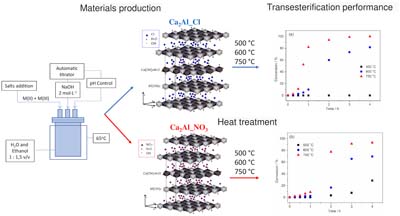
Synthesis of heterogeneous catalysts derived from thermal treatments on hydrocalumite-type compounds intercalated with chloride and nitrate anions was carried out. The prepared catalysts were used in transesterification reactions to produce biodiesel.
https://dx.doi.org/10.21577/0103-5053.20220082
J. Braz. Chem. Soc. 2023, 34(1), 13-24
Efficient Encapsulation and Controlled Release of N,N-Diethyl-3-methylbenzamide (DEET) from Oil-in-Water Emulsions Stabilized by Cationic Nanocellulose and Silica Nanoparticles
Luis M. Gutierrez-Beleño  ; Vincenzo Calabrese
; Vincenzo Calabrese  ; Janet L. Scott
; Janet L. Scott  ; Karen J. Edler
; Karen J. Edler  ; Aurora Pérez-Gramatges
; Aurora Pérez-Gramatges

Stabilization of oil-in-water emulsions containing N,N-diethyl-3-methylbenzamide (DEET) using oppositely charged cationic cellulose nanofibrils (CCNF) and silica nanoparticles (SiNP) to allow extended and sustained release of DEET.
https://dx.doi.org/10.21577/0103-5053.20220084
J. Braz. Chem. Soc. 2023, 34(1), 25-35
Synthesis and Evaluation of Antibacterial Activity of 1,2,3-Triazole and Ether Derivatives of Paeonol
Laura Patricia R. Figueroa; Nayara A. dos Santos; Pedro Henrique O. Santiago; Wanderson Romão  ; Valdemar Lacerda Junior
; Valdemar Lacerda Junior  ; Javier Ellena
; Javier Ellena  ; Ana Camila Micheletti; Warley S. Borges
; Ana Camila Micheletti; Warley S. Borges
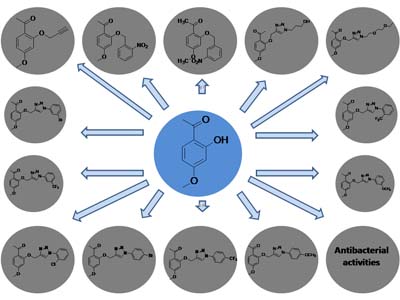
Paeonol derivatives were synthesized and their biological activities tested.
https://dx.doi.org/10.21577/0103-5053.20220085
J. Braz. Chem. Soc. 2023, 34(1), 36-53
Evaluation of the Properties of LaNiO3 Material Prepared by the Modified Proteic Method for Adsorption of Environmental Contaminants
Jéssica A. S. Lemos; Iasmin A. Ribeiro; Marcelo J. B. Souza; Anne M. Garrido Pedrosa
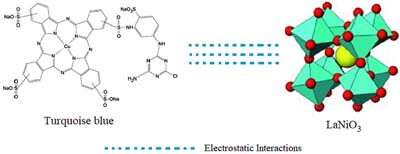
The removal of environmental contaminants such as Turquoise Blue dye from an aqueous medium can be made using LaNiO3 material, with perovskite structure, and occurs due to electrostatic interactions between both.
https://dx.doi.org/10.21577/0103-5053.20220086
J. Braz. Chem. Soc. 2023, 34(1), 54-62
Lipid Profile of Human Milk in Different Lactation Stages Submitted to Pasteurization, Lyophilization and Spray-Drying Processes
Vanessa J. C. Neia  ; Patrícia D. S. Santos; Christyna B. G. Tavares
; Patrícia D. S. Santos; Christyna B. G. Tavares  ; Meliana G. Paula
; Meliana G. Paula  ; Silvio C. Costa; Joana M. V. Zacarias; Josiane B. Alencar; Roberta Silveira
; Silvio C. Costa; Joana M. V. Zacarias; Josiane B. Alencar; Roberta Silveira  ; Oscar O. Santos
; Oscar O. Santos  ; Jeane E. L. Visentainer
; Jeane E. L. Visentainer  ; Jesuí V. Visentainer
; Jesuí V. Visentainer
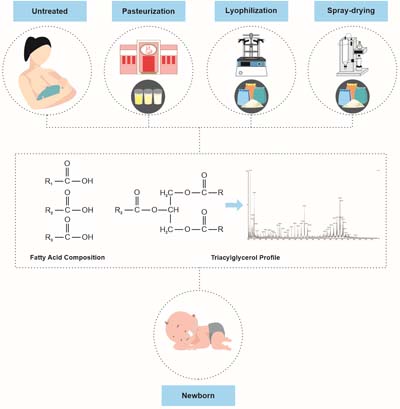
Effect of pasteurization, lyophilization and spray-drying processes on the lipid profile of colostrum, transitional and mature human milk.
https://dx.doi.org/10.21577/0103-5053.20220087
J. Braz. Chem. Soc. 2023, 34(1), 63-68
Nicotine as a Catalyst for Chlorination Promoted by Hypochlorous Acid: Experimental and Theoretical Studies
Valdecir F. Ximenes  ; Nathalia M. Pavan; Aguinaldo R. de Souza; Gabriel A. Barros; Nelson H. Morgon
; Nathalia M. Pavan; Aguinaldo R. de Souza; Gabriel A. Barros; Nelson H. Morgon
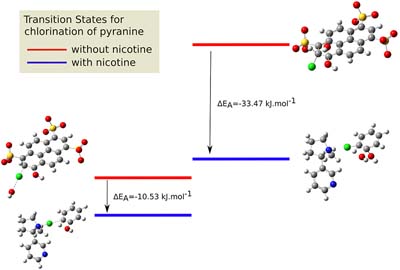
Hypochlorous acid (HClO) is an endogenous oxidant, and nicotine is the primary addictive component of tobacco smoke. Nicotine catalyzes the chlorination of biomolecules. This paper describes the mechanism of the catalytic effect of nicotine.
https://dx.doi.org/10.21577/0103-5053.20220088
J. Braz. Chem. Soc. 2023, 34(1), 69-82
The Contribution of Meteorological Parameters and the COVID-19 Partial Lockdown on Air Quality in Rio de Janeiro, Brazil
Karmel Beringui  ; Elizanne P. S. Justo
; Elizanne P. S. Justo  ; Luciana M. B. Ventura
; Luciana M. B. Ventura  ; Ruan G. S. Gomes; Vinícius Lionel-Mateus
; Ruan G. S. Gomes; Vinícius Lionel-Mateus  ;
;
Alex H. De La Cruz  ; Ana Carolina L. B. de Almeida; Michelle B. Ramos; Julio Angeles Suazo; Pedro H. R. Valle; Adriana Gioda
; Ana Carolina L. B. de Almeida; Michelle B. Ramos; Julio Angeles Suazo; Pedro H. R. Valle; Adriana Gioda
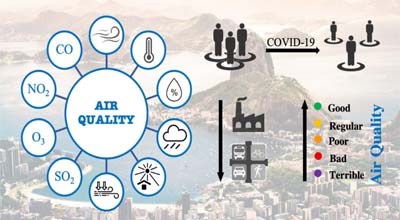
After a partial lockdown decree in Rio de Janeiro, reductions in pollutant sources were the main factor explaining lower concentrations of criteria pollutants. Meteorological conditions, similar to previous year, favor pollutant dispersion by sea breeze.
https://dx.doi.org/10.21577/0103-5053.20220089
J. Braz. Chem. Soc. 2023, 34(1), 83-91
Influence of Refinery Asphalt Residue Addition on Flow: A Study Using Waxy Model-System
Ana Carla F. Valente; Rita C. P. Nunes; Elizabete F. Lucas
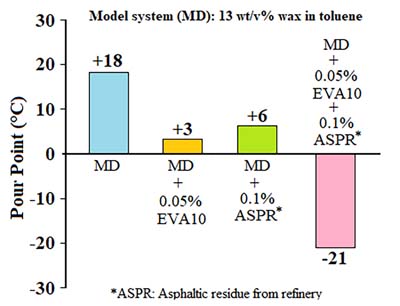
Synergistic effect of poly(ethylene-co-vinyl acetate) (EVA) copolymer and asphaltic residue from refinery on the reduction of pour point.
https://dx.doi.org/10.21577/0103-5053.20220090
J. Braz. Chem. Soc. 2023, 34(1), 92-102
Bimetallic Au-Pd/α-MoO3 Catalyst with High Oxygen Vacancies for Selective Oxidation of Cinnamyl Alcohol
Renilma C. Sousa; Jussara M. da Silva; Jean C. S. Costa  ; Carla V. R. de Moura
; Carla V. R. de Moura  ; Edmilson M. de Moura
; Edmilson M. de Moura
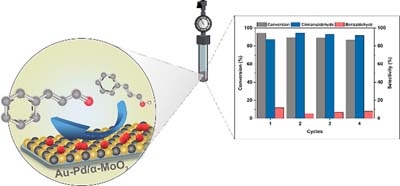
The α-MoO3 support employed in this work allows the synthesis of potentially active and selective Au-Pd catalysts for the aerobic oxidation of cinnamyl alcohol under base and solvent-free conditions.
https://dx.doi.org/10.21577/0103-5053.20220091
J. Braz. Chem. Soc. 2023, 34(1), 103-111
Carbon Dots from Pilosocereus gounellei for Fluorimetric Determination of Tannin in Tea Using a Flow-Batch System
Kelly D. Silva  ; Stéfani I. E. Andrade
; Stéfani I. E. Andrade  ; Marcelo B. Lima
; Marcelo B. Lima  ; Severino S. Monte-Filho
; Severino S. Monte-Filho  ; Mário C. U. Araújo
; Mário C. U. Araújo  ; Ricardo A. C. Lima
; Ricardo A. C. Lima
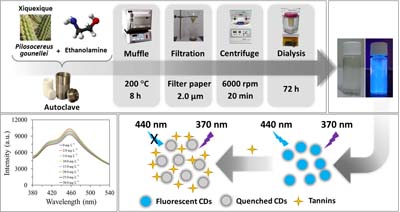
Carbon dots from Pilosocereus gounellei were used to develop a fast, low-cost, eco-friendly fluorescence flow-batch method for the determination of tannins in teas.
https://dx.doi.org/10.21577/0103-5053.20220092
J. Braz. Chem. Soc. 2023, 34(1), 112-123
Study of Catalytic Pyrolysis of Biomass Sorghum (Sorghum bicolor L. Moench) Using Design of Experiments and Surface Response Methodology
Diego M. Costa; Maria L. F. Simeone  ; Rafael A. C. Parrella; Isabel C. P. Fortes
; Rafael A. C. Parrella; Isabel C. P. Fortes
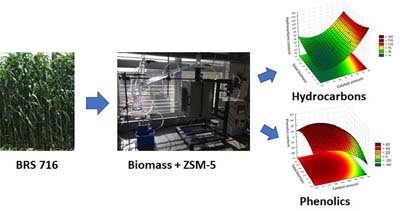
Samples of biomass sorghum BRS716 were submitted to fast catalytic pyrolysis to produce a bio-oil rich in hydrocarbon or phenolic compounds after optimizing the suitable critical process parameters using a response surface methodology approach.
https://dx.doi.org/10.21577/0103-5053.20220093
J. Braz. Chem. Soc. 2023, 34(1), 124-134
Encoding of Luminescent Ink Markers Using Low-Level Data Fusion and Chemometrics
Caroline R. Carneiro  ; Isabela B. Serwy; Carolina S. Silva
; Isabela B. Serwy; Carolina S. Silva  ; Ingrid T. Weber
; Ingrid T. Weber
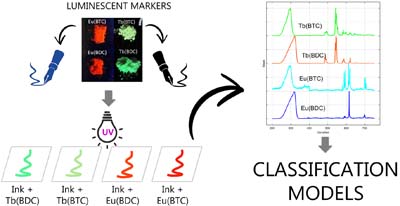
Chemometric tools make it possible to differentiate the luminescent markers inserted in the ink, creating a document encoding process.
https://dx.doi.org/10.21577/0103-5053.20220094
J. Braz. Chem. Soc. 2023, 34(1), 135-145
Honey of Tetragonisca angustula from Southwestern Bahia: Influence of Seasonality on the Physicochemical Profile and Glioma Cell Inhibitory Effect
Adrianne B. Ferreira  ; Cleber G. Novaes
; Cleber G. Novaes  ; Hion O. de Jesus; Julita Maria P. Borges; Florisvaldo S. Ramos; Anderson J. Pereira; Djalma M. de Oliveira; Rosane M. Aguiar
; Hion O. de Jesus; Julita Maria P. Borges; Florisvaldo S. Ramos; Anderson J. Pereira; Djalma M. de Oliveira; Rosane M. Aguiar
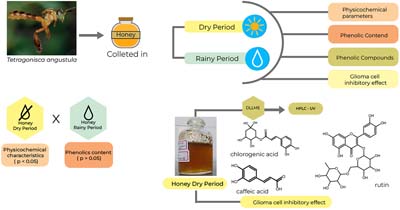
Tetragonisca angustula stingless bee honey collected in dry and rainy periods were subjected to analysis of physicochemical parameters, phenolic content, identification of phenolic compounds by high-performance liquid chromatography with ultraviolet detection (HPLC-UV) and glioma cell inhibitory effect.
https://dx.doi.org/10.21577/0103-5053.20220095
Short Report J. Braz. Chem. Soc. 2023, 34(1), 146-152
Phenolic Compounds from Leaves of Cariniana estrellensis (Raddi) Kuntze (Lecythidaceae): A Brazilian Atlantic Forest Tree
Angelica N. Tiepo  ; Isabel D. Coutinho; Guilherme O. Machado; Halley C. Oliveira
; Isabel D. Coutinho; Guilherme O. Machado; Halley C. Oliveira  ; José Antonio Pimenta
; José Antonio Pimenta  ; Liliane Marcia M. Henning
; Liliane Marcia M. Henning  ; Luiz Alberto Colnago; Renata Stolf-Moreira
; Luiz Alberto Colnago; Renata Stolf-Moreira
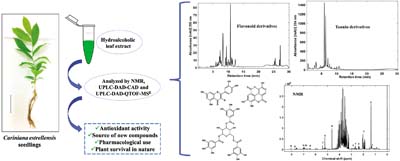
Cariniana estrellensis seedlings are used in forest restoration programs in the Atlantic Forest biome. We used rapid analysis by nuclear magnetic resonance and liquid chromatography coupled to diode array, charged aerosol, and mass detection to provide the first data on secondary metabolism from C. estrellensis. We identified hydrolysable tannins, hydroxycinnamic acids, and flavonoids.
https://dx.doi.org/10.21577/0103-5053.20220083
Online version ISSN 1678-4790 Printed version ISSN 0103-5053
Journal of the Brazilian Chemical Society
JBCS Editorial and Publishing Office
University of Campinas - UNICAMP
13083-970 Campinas-SP, Brazil
Free access










